January 9, 2022
Brougham existed for 150 years as a quiet rural community that supported agriculture on the surrounding farms. Brougham had one claim to historical fame that came from a local man named Peter Matthews. The veteran of the War of 1812 was well respected in town and also a vocal supporter of democratic reforms. On December 2, 1837, Peter led a group of local men to join William Lyon Mackenzie in an armed rebellion against the government in Toronto. The rebellion failed but Matthews and another rebel named Samuel Lount were convicted of treason and publicly hanged. Matthews and Lount are buried in The Necropolis in Toronto.
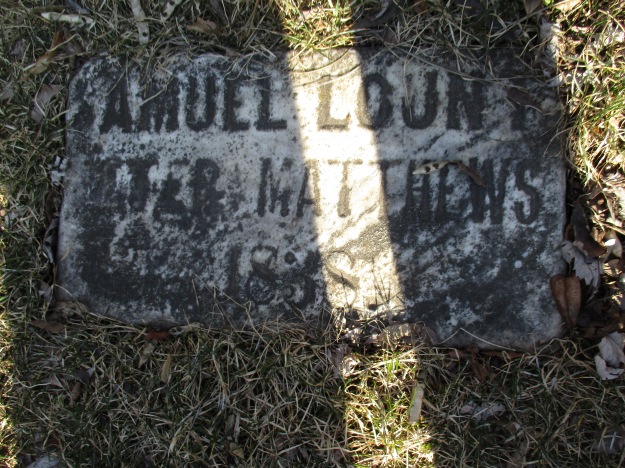
When the excitement died down, Brougham went back to being a quiet hamlet where not much ever happened. That suddenly changed in 1972 when the Federal Government of Pierre Trudeau expropriated the entire community for an airport that it claimed would be operational by 1979. That airport was never built but the lands have been held in trust for a potential future airport.
William Bentley became one of the founders of Brougham after he emigrated from New York State in 1839 and settled in Pickering Township. Along with his brothers, he established a general store as well as a patent medicine factory. William built this house in 1853 at the main intersection of town and it quickly came to represent the prosperity of the community. The home boasts Italianate styling in the architecture including the belvedere on the roof. It’s interesting to see it sitting empty while carrying a Federal Historic Register designation and sitting on a potential airport flight path leading to a runway.
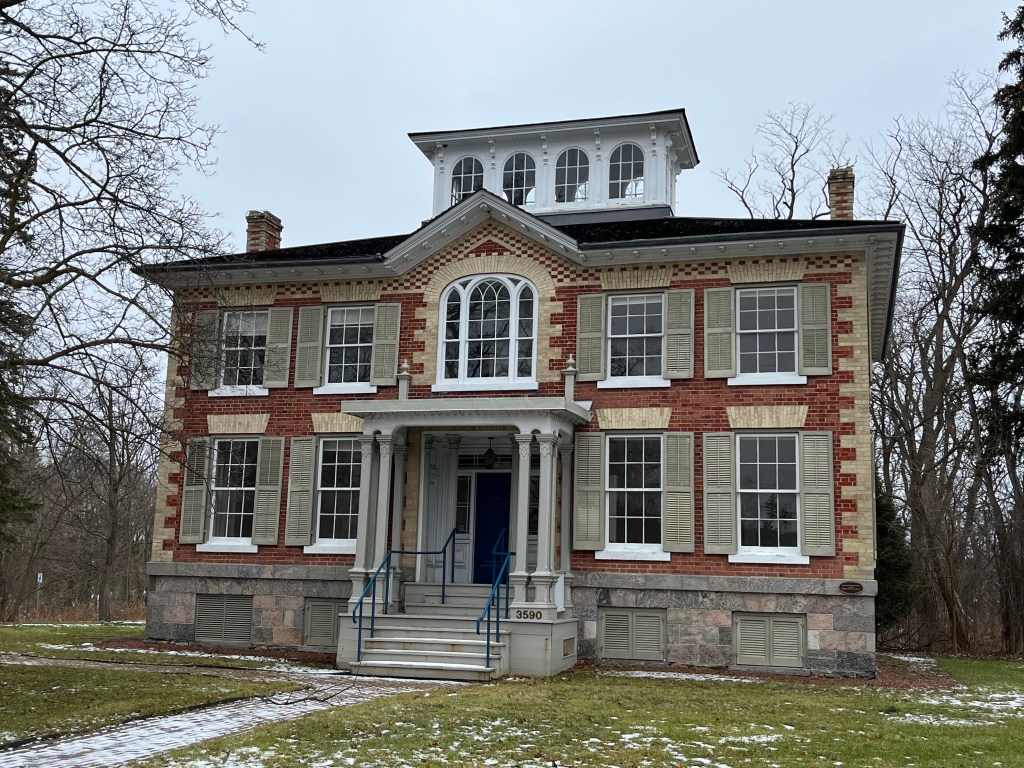
Constructed in 1854 as Pickering Town Hall, this wood-framed building was designed as an open concept meeting area for making community decisions. As such, it is fitting that it became the site of community meetings in 1972 to fight the federal government’s decision to expropriate the community in the name of a new airport. People Or Planes was a larger citizens group from throughout the original expropriated lands and beyond. They banded together and fought to stop the government from going ahead. Their success has kept these lands from being destroyed for the past half a century. For years it read “Pickering Community Hall” but the name has been changed above the entrance to reflect the community that it represented. This building also has a Federal Historic Designation, this one given in 2009. Just beside the community hall is a one-storey Georgian home with dichromate brick veneer that was built in 1860. As I was photographing the community hall the two residents next door asked me what I was doing. When I explained that I was photographing historic buildings we got into an interesting conversation about the community and the airport plans. I haven’t included their home out of respect for them, but it is listed on the Pickering Municipal Heritage Register (PMHR).

Brougham decided to replace their original wooden schoolhouse with a new brick one in 1859. It served the children of the community for 100 years before being closed. Recently it has been used as an art gallery and the building appears on the Federal Heritage Register.
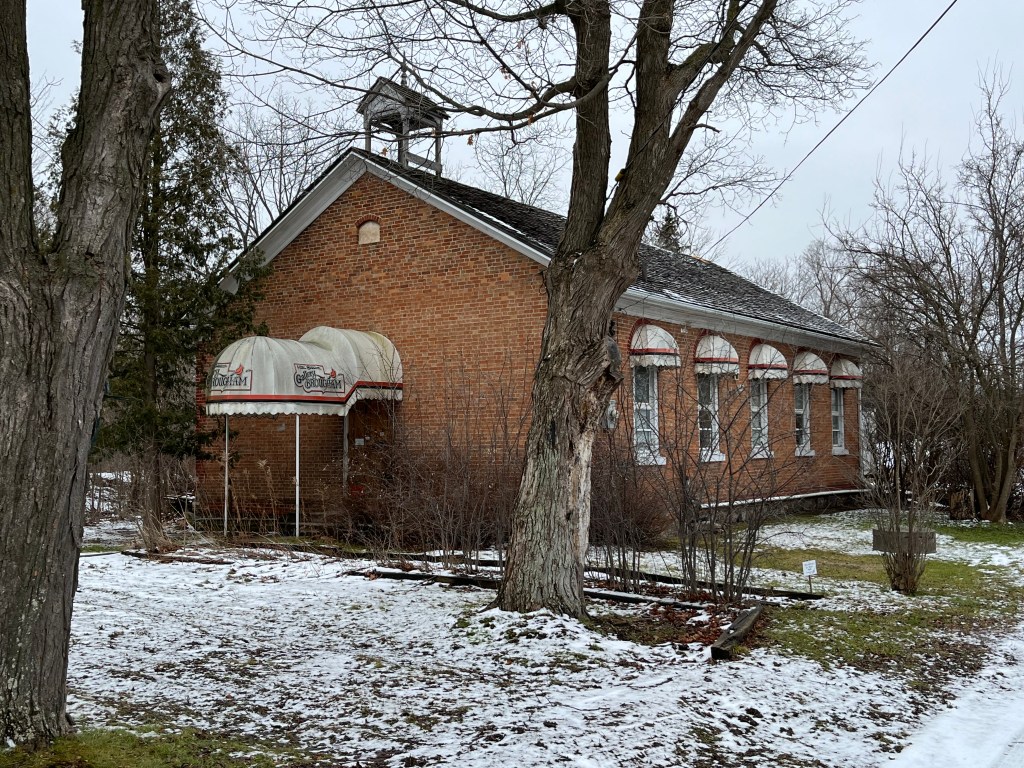
The Wesleyan Methodists came to town early but the small size of the congregation didn’t allow them to have their own full-time pastor. Records indicate that in 1870 they were part of the Pickering circuit in which they shared a pastor on a rotation that included Claremont, Glen Major, Greenwood, and Kinsdale. By 1890 they were able to erect this handsome brick building at the main intersection in town. After 1925 it was known as St. John’s United Church. Today it carries on ministry as Pickering Standard Church and is listed on the PMHR.

The Temperance hall was built in 1880 and is listed on the PMHR. The Temperance Movement sought to restict or ban the consumption of alcohol and got started around 1820. Through various successes and failures they eventually managed to see legislation passed in both Canada and the United States that prohibited the sale of alcohol. The Temperance Hall in Bougham appears to have been raised at some point and a second floor added beneath. This could account for the fact that the brick butresses are not continued on the lower floor making them essentially useless. Early pictures of the main street show the building as it looks today but the windows are not bricked shut.
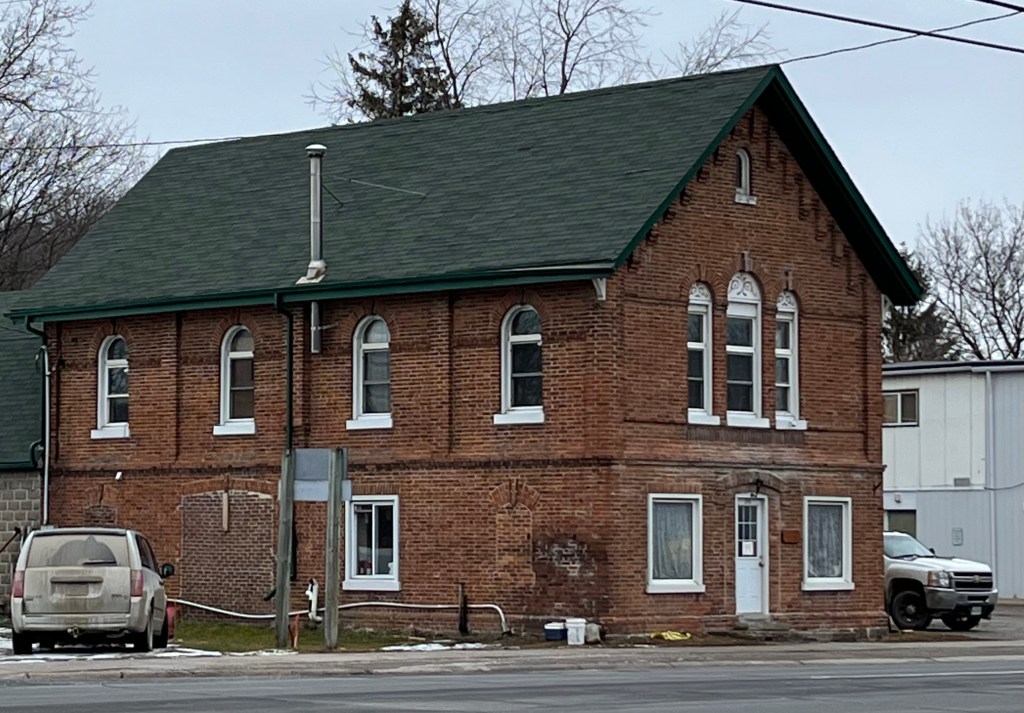
The former Commercial Hotel was built as a private home in 1860 and later converted into a hotel. It faces Highway 7 on the east end of town and is the last of three hotels that used to serve travelers through the hamlet. The former hotel has some interesting Gothic Revival architectural features. The pointed arch windows in the two second-storey gables are augmented by the decorative bargeboard or gingerbread trim. Each is topped by a finial (the pointed decoration) that makes it distinctive. In 2009 this building was added to the Federal Heritage Register which seems at odds with the plan to level the town for an airport.

The Miller Residence was built in 1880 and is the fifth building in town to appear on the Federal Heritage Register. This house was occupied by several leading families in the community over the years including the Bentleys, Hubbards, and Millers. The house is representative of late Victorian architecture in that it includes several styles such as Gothic Revival bargeboards and Italianate windows with rounded arches.
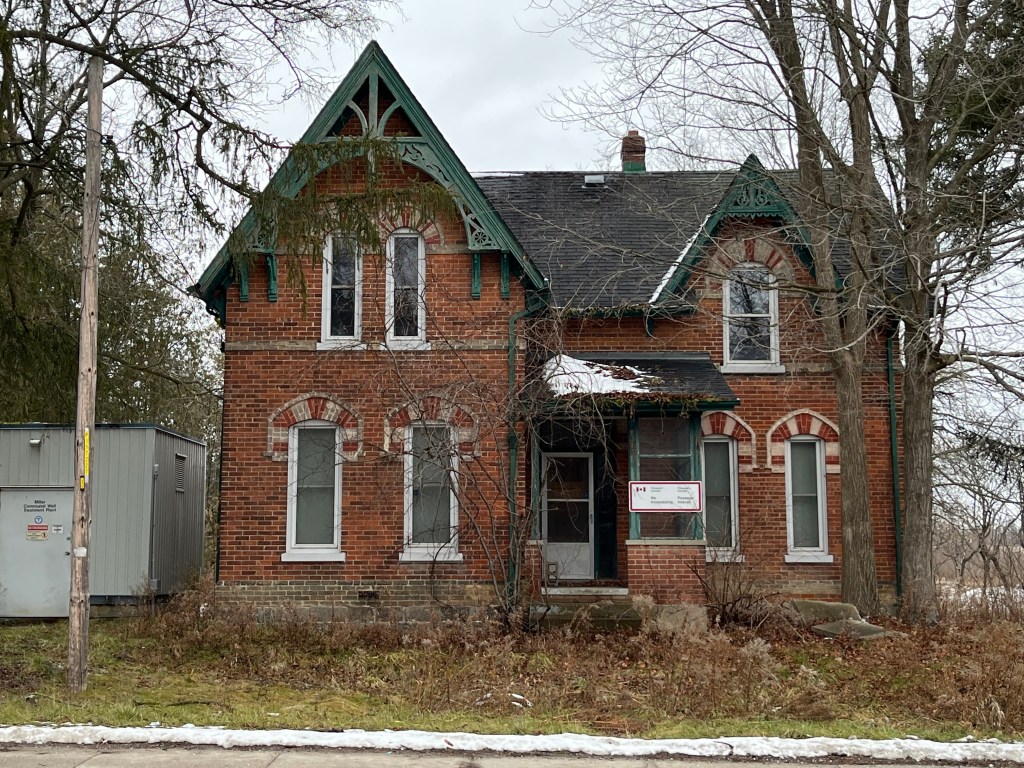
On the north side of the community hall is this 1 1/2- storey house which was built in 1860. It is typical of many homes that were built in this era with its centre gable and pointed arch window. This house is listed on the PMHR.

Just on the north edge of town, there stands a house that is also listed on the Pickering Municipal Heritage Register. It was built in 1860 and is shown on the County Atlas as being on the property of R. Lambert. The register lists it as the ex-Vanderligt home but on March 16, 2021, a fire broke out in the house. The two occupants were able to escape, but the fire department reported “extensive damage”. It’s unlikely that the federal government will want to restore the building because it solves the problem of yet another building on the PMHR.

Brougham is a community of driveways that go nowhere and vacant lots. With the government owning every property in town with an undisclosed demolition date no one wanted to invest in maintenance. Slowly people moved on and buildings were demolished as they became increasingly dilapidated.

In March of 1972, the federal government announced plans to build a major airport in Pickering to take the expected overflow from Malton Airport (Pearson International). they went ahead and expropriated 18,600 acres (7,530 hectares) and began making plans for construction. By 1975 construction was halted and the farmlands and houses were leased out for interim use. Recent studies suggest that the airport might be needed between 2027 and 2037, but might never be, and the federal government has given two large portions of the land to create Rouge National Urban Park. A study by KPMG concludes that it will not be necessary and Covid may have a lasting negative effect on the airline industry as well. The government remains committed to developing an airport on the reduced lands which include Brougham. The Transport Canada map below shows the original airport site in yellow and the reduced one in purple. Brougham is located in the extreme lower right-hand corner of the site but would be under an approach flight path. Land Over Landings carries on the work of People or Planes in fighting to save not only the communities involved but the farmland as well. There’s a great deal more information that’s available on their website Land Over Landings.

While the government is still actively talking about building the airport, the locals have slowly gone about the job of obtaining historical designations. With almost every property in Brougham listed on one heritage register or another, it will be interesting to see how the Federal Government goes about building an airport in the face of the existing local history.
To read more about the Rebellion of 1837 check out our story Rebel Rebel. You can also check out our story The Necropolis.
Google Maps Link: Brougham
Like us at http://www.facebook.com/hikingthegta
Follow us at http://www.hikingthegta.com
Also, look for us on Instagram

Great article about the buildings, but wow have you left out a lot of information. This is decidedly NOT a ghost town. I grew up here and my parents and many of their friends and neighbours still live there. They are a close knit community and most, if not all, are members of the advocacy group Land Over Landings, which has been fighting the development of the lands for decades. They were preceded by People Over Planes and the advocacy for protection of these lands is now in its 50th year. I find it insulting that you would refer to this as a “ghost town” without mentioning any of the hard work and dedication of residents to keep it alive. Not only that but the gist of the KPMG study was in fact closer to ‘no airport should be built here’ than one will be needed in the future. Your interest in the heritage is admirable, but this is not some quaint forgotten place that exist for story telling. This is a living, breathing community of people who have fought tooth and nail to exist and to save this perfect and beautiful farmland for a future that will desperately need it. The future is not more airports; it’s fresh food, water, and air, which will be in short supply if we just keep paving. This village and the lands the surround it are not only valuable for their history. Their value for the future is immeasurable.
I’m with you 101 percent. We moved from Toronto to Kingston because the urban sprawl over pristine farmland (once forest) was too disheartening. Unfortunately the same b.s. is happening here. Anyway, I admire the determination your community had shown over the decades. Keep up the fight.
I was gone years old when my father and mother move me away from Brougham because they were going to build an airport at that time I am now 63 years old and the only thing they’ve done has allowed a factory to be built the baseball diamond to be relocated so anything that comes out of the governments mouth you cannot believe I was I did was uproot our families and friends
Thank you, thank you for this excellent post! As a former educational instructor at the Pickering Museum Village and co-author of ‘A Spirit Walk’ (celebrating the local heroes of the 1837 ‘Farmers’ Revolt’), former member of the Pickering LACAC, 41 yr-resident of a 165-yr-old farmhouse in the edge of Brougham and long time chair of @LandOverLandings, I was braced for errors — and found none!! Or at least none of an historical or architectural nature….
Your conclusion re the latest government study is slightly skewed, but understandably, given the propaganda campaign being mounted by the local government. The KPMG study concluded, like every study before it, that there this no business case for an airport. It will review again in 2036 — unless we can protect the remaining 9000 acres and have them added to the Rouge National Urban Park.
I do wish your article had referenced People or Planes, the magnificent army of citizens who rose to fight the governments and stop the airport — and won! Because of them, Land Over Landings can continue to fight for these prime farmlands and watersheds, and the few remaining heritage structures.
For those who fear they will be torn down, no worries. They won’t. They may be neglected and left to rot, but the demolitions that saw the unnecessary and grotesque destruction of literally hundreds of structures on these Lands has ended.
It’s half a century since the first Prime Minister Trudeau expropriated these farms, homes, and thriving rural communities. Ending it once and for all is in the hands of his son, the current prime minister Trudeau. He celebrated his 50th birthday on Dec 25. On March 2 we celebrate half a century of citizen action and mark #50YearsofNoPickeringAirport! https://youtu.be/ZscTrTpo9zs
Thank you Mary for your indepth comment. I went back and made a couple of changes and provided a link to the Land Over Landings web page.
Thank you so much again!! It is a long and complicated saga, and resulting articles are often (understandably) rife with error. Yours was so good. It was clear that your intent was to be as accurate and as detailed as possible. We are grateful to those who, like yourself, take the time and make the effort to get it right.
Before the demolitions ended, we had friends renting one of the farmhouses on this airport land for many years. When the furnace broke down, and could not be repaired, I understand the gov’t told them they weren’t responsible for repairs/maintenance. They were told to move and after that, the house and adjacent buildings were torn down. *Sad* that so many homes were demolished
The money that has poured into this Airport is in the millions. I hope the people who want to save this land are ready to reimburse us taxpayers all the money taken.
Gosh, Paul, its not millions! When you factor in the cost of to Transport Canada of expropriating all those properties, maintaining the Lands for half a century, and doing endless studies, the cost is in the hundreds of millions, perhaps billions! But the cost of that waste is firmly on the shoulders of successive federal governments, not the citizens who fought the airport.
Brougham and area was a thriving and prosperous farm community at the time of expropriations. The years since, with one-year leases and the ever-present threat of an airport, have meant nothing but waste and loss — of jobs, businesses, and economic growth. Rest assured, the government has owned the Lands for half a century — if there was a sound business case for an airport they would have built it! But the fact is that every study, up to an including the most recent by KPMG — all paid for by you and me! — have said the same thing: there is NO business case for an airport.
If the Lands were freed from this threat they could prosper again as an agritourism hub next to our largest urban centre.
For more, please visit landoverlandings.com. Or read here, a report from 2016. The numbers within have only gone up in the intervening years.
Pickering Airport: What Has This Boondoggle* Cost Us? (update June 2016)
*boondoggle: a wasteful or pointless project that gives the appearance of having value We Canadians, through our taxes, have paid for:
the many site searches and consultants’ studies and reports, from 1968 to 1972, that resulted in the selection of north Pickering in February of 1972 as the site of an international airport
the expropriation of 18,600 acres (farmland, natural habitat, and two villages)
all the post-decision hearings, inquiries, and studies that were conducted on the taxpayers’ dime:
environmental studies/assessments
the Swackhamer Hearing (1972); the Gibson Inquiry (1973) the wildlife, weather, and water monitoring studies
the cultural and heritage studies, including the Draper (Wendat) site excavation, and the massive “Architectural Evaluation of the North Pickering Project and the Toronto Area Airports Project Sites” (1974)
the study by the Pickering Airport Lands Revitalization Committee (PARC) (1985-86)
undoubtedly other studies that remain unknown to the public
the renovation, furnishing, and maintenance of government site offices on the Federal Lands
the demolition of hundreds of structures on the site – houses, barns, commercial buildings, and outbuildings – over a period of 41 years
more than 44 years of government administration of the Lands, including the salaries and benefits of an unknown number of Transport Canada and Public Works Canada staff and the fees paid to SNC-Lavalin Property Management and other sub-contractors
the consequences of Transport Canada’s policies of intentional neglect as landlord of the Pickering site (Ottawa has foregone millions in revenue through the department’s refusal to re-rent vacated houses; financial records obtained by the National Post from Transport Canada show that environmental, green space, regular, and other operating/maintenance costs – no details provided, and overhead excluded – exceeded rental income by close to $26 million for 1999–2005 alone)
41 years of inspections of leased properties and of the rehousing or eviction of tenants
41 years of maintenance (including, 3 decades’-worth grudgingly and shoddily performed by
Public Works Canada or their subcontractors) on leased properties on the Lands
the federal government’s legal costs to fight tenants who took Public Works Canada (Transport Canada’s property manager until 2005) to court over shoddy practices and fabricating reasons for eviction, and the resulting costs when the courts sided with the tenants
4 decades of funding security patrols on the Lands
… and there’s more
Transport Minister David Collenette’s Federal Green Space Preserve initiative for the Lands, including several roundtable meetings with “stakeholders” and a significant consultant’s report (2003)
the “technical” study commissioned by Transport Canada in 2001 from the Greater Toronto Airports Authority (GTAA), resulting in the Pickering Airport Draft Plan Report and a related Financial Assessment Analysis by consultants Landrum &Brown and ArupNAPA (2004)
the needs assessment study commissioned by Transport Canada in 2007 from the GTAA, resulting in the Needs Assessment Study / Pickering Lands, Final Report (2010)
the Independent Advisor’s study of the Land’s economic development potential (2015-16) And soon we will be paying for
Transport Canada’s newly tendered high-powered, multi-year “Pickering Lands Aviation Sector Analysis” to determine (you guessed it) if a Pickering airport is needed
We will likely never know how many millions – or, more likely, billions – of taxpayers’ dollars this mess has cost us, and it’s not over yet. Will these latest studies result in change here, or will they be shelved the way so many others have been shelved before them? The 2010 needs assessment study suggested that since a Pickering airport could be needed in 15, 25, or 31 years – or at some unknown time after that – the government should go on administering the Lands. Translation: taxpayers should go on paying the bill for however long it takes.
Compare with:
– the cost to the federal treasury of administering the Federal Lands prior to 1972? Zero. – the cost to the federal treasury if the Pickering site had never been expropriated? Zero.
JOIN US IN DEMANDING AN END TO THIS BOONDOGGLE!
For more information, contact
Land Over Landings
905-649-2433 landoverlanding@gmail.com http://www.landoverlandings.com
Pingback: One Room Schools | Hiking the GTA
Pingback: Mongolia – Ghost Towns of the GTA | Hiking the GTA
Great Article, hopefully some of the community of heritage homes will be restored as a restaurant or a gas bar in the New Seaton. Bye bye Westvale, Green River… the rest will be overcome by industry, highways, and cool new ‘green’ subdivisions. Finally some use for the lands, other than whiney renters. Duffin Creek system protection and public access should be paramount, but I’m sure it will suffer short-term and benefit in the long run.
Hi, Brad —
Confused by some of your comments. Figured out ‘Westvale’ (you mean Whitevale, correct?). And I understand that you believe a gas bar is an appropriate use for a heritage house, and that agriculture is not an appropriate use for the best farmland in the country. But you’ve lost me with what appears to be a suggestion that something different is coming for the Federal Lands. What in the article lead you to this conclusion? Is it that you think the Lands will, in fact, be used for an airport after half a century of every study saying there is no need and no business case? Or do you believe there is another future for the Lands and a “benefit in the long run”? If so, what? Please explain.
Not trying to be difficult, just genuinely confused.
Best regards,
Mary Delaney
Pickering Airport never was, however Mirabel airport north of Montreal was
Another airport farce , it was built used for awhile as international flights now has little flights. I think Pierre Trudeau opened it just before he brought wage and price constraints : famous line “Eat,
Drink and be merry, for tomorrow we practice restraints”
Pingback: Altona – Ghost Towns of the GTA | Hiking the GTA